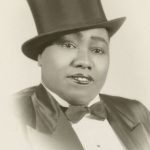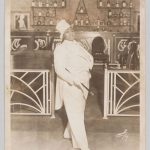- Gladys Bentley’s powerful voice, fiery energy on the piano and bold lyrics made her a star of New York City nightclubs. (NMAAHC)
- 2. Gladys Bentley by unidentified photographer, ca. 1940 (NMAAHC)
- Courtesy of Wikimedia
- Bentley looking over a scrapbook of her career, circa 1952
Gladys Bentley
Born: August 12, 1907 Died: January 18, 1960
What she did: Harlem Renaissance Entertainer
Facts:
- Gladys was born in Pennsylvania. Her father George was American and her mother, Mary, was Trinidadian. Unfortunately, hers was not a happy childhood.
- The eldest of 4 children in a low-income family, Gladys struggled. It didn’t help that Gladys’ mother wished she had been a boy.
- Gladys wrote later in her life, “When they told my mother she had given birth to a girl, she refused to touch me. She wouldn’t even nurse me and my grandmother had to raise me for 6 months on a bottle before they could persuade my mother to take care of her own baby.”
- This rejection made Gladys resentful towards her brothers and she hated the idea of a man touching her.
- From a young age, Gladys didn’t conform to gender norms of the day. She wore boys’ clothes, had a crush on a female elementary teacher, and didn’t behave in a ‘lady-like’ manner.
- She wrote, “It seems I was born different. At least, I always thought I was.”
- Disturbed by their daughter’s lack of dress-wearing, Gladys’ parents took her to doctors because y’know, this was clearly a medical issue. Gladys was later diagnosed with “extreme social maladjustment.”
- This toxic home life drove Gladys to run away to Harlem when she was 16 years old in 1923.
- Gladys had a natural talent as a pianist and blues singer. She quickly found work as a performer, especially in speakeasies which were popular during prohibition.
- She started out recording 8 tracks of music for $400.
- Then she heard that a local gay bar, Harry Hansberry’s Clam House, was looking for a male pianist. Already perfectly comfortable wearing suites, Gladys began playing there dressed as a man under the stage name Barbara “Bobbie” Minton. She started out at $35 a week and went up to $125 due to her success.
- Her act became so popular that the bar was renamed “Barbara’s Exclusive Club” after her stage name.
- Gladys then began performing at the Ubangi Club on Park Avenue where she created her own musical revue with a chorus of 8 male dancers all in drag. She started making enough money she was able to afford a $300/month apartment on Park Ave along with servants and a nice car.
- Gladys’ signature look was a white tuxedo and white top hat. Her acts included overt sexuality and her deep voice appealed to audiences across the sexual and racial spectrum.
- In her songs, she would call out misogyny and sing about sexual relationships, including her own with women.
- By 1933, Gladys was headlining at prominent nightclubs and theaters including the Apollo.
- Her skill didn’t go unnoticed. Langston Hughes wrote of Gladys:
- “For 2 or 3 amazing years, Miss Bentley sat and played piano all night long with scarcely a break between the notes, sliding from one song to another, with a powerful and continuous underbeat of jungle rhythm. Miss Bentley was an amazing exhibition of musical energy- a large, dark, masculine lady whose feet pounded the floor while her fingers pounded the keyboard- a perfect piece of African sculpture, animated by her own rhythm.”
- In 1932, Gladys publicly married a white woman during a civil ceremony in New Jersey. We don’t know who the woman was or much about their marriage.
- When Gladys tried to take her show to Broadway in 1933, the owners of the Clam House club she had been playing at sued her, saying that their club had been built around Gladys’ music and that they had a 5-year contract with Gladys’ and her performances.
- This led to a Supreme Court battle as Gladys tried to take more control over her career. Despite the suite, Gladys moved her act to Broadway. Unfortunately, her raunchy performances caused people to complain and the police began locking the doors of places she performed.
- This forced her to move back to Harlem where she performed at the Ubangi Club for 3 more years before it closed in 1937.
- The decline of prohibition was great for everyone, but it resulted in the decline of Harlem speakeasies which hurt Gladys’ career.
- She moved to southern California where she played at gay nightclubs and was billed as “America’s Greatest Sepia Piano Player” and the “Brown Bomber of Sophisticated Songs.”
- What hurt her more than the end of prohibition was the government’s increasing criminalization of LGBTQ+ people. Due to federal laws, Gladys had to carry a special permit to be allowed to perform in her signature suites.
- Then in the 1950s U.S. senator Joseph McCarthy came on the scene.
- McCarthy was an infamous fear monger who was super popular
during the Cold War era when everyone was waiting for Russia to Nuke the United States. - McCarthyism, the practice of accusing people of treason, being a communist, or whatever else you felt like, was named after him.
- During this time, people were being accused of having communist sympathies or being traitors to the United States.
- It didn’t take much to become accused of something. Being a black lesbian who wore suites made Gladys a target.
- McCarthy was an infamous fear monger who was super popular
- Gladys suddenly began wearing dresses and married a man whom she only knew for 5 months.
- She claimed she had been ‘cured’ of her lesbianism by taking female hormones and undergoing an operation.
- They divorced later and the dude later denied he and Gladys were ever married.
- On January 8th , 1960 at the age of 52, Gladys died unexpectedly from Pneumonia in her Los Angeles home.
- Just before her death, she had been ordained as a minister, but never got her official paperwork.
LEGACY
- Gladys was challenging societal norms of gender, sexuality, and entertainment from day 1. Her masculine attire and public relationships with women in a time when being ‘out’ was dangerous and unaccepted.
- Gladys never attempted to ‘pass’ as a man but displayed an energy of ‘black female masculinity’ that challenged her audience’s views on race and sexuality.
- Fencing Lesson. Artwork by Charlotte
- Julie d’Aubgny | © Jean Béraud / WikiCommons
- “Mademoiselle Maupin de l’Opera”. Anonymous print, ca. 1700. From the resource History Masquerade
- La Maupin, L’Heroine Cover page of the French magazine “Le Matin” (Morning), 1910s
Julie d’Aubigny aka La Maupin
Born: 1670 Died: 1708
What she did: Sword-slinging opera singer, and larger-than-life bisexual celebrity of 17th-century France.
Facts:
- Julie d’Aubigny was born in France around 1673. She was the only child to a secretary to King Louis XIV’s Master of Horse, Count d’Armagnac, one of France’s great nobles.
- After first living in the riding school at the Tuileries Palace in Paris (where she learned to ride and take care of horses), she then moved with the court to the opulent Palace of Versailles in 1682.
- While her father worked in King Louis XIV’s luxurious court, Julie d’Aubigny grew up in less-glamorous quarters, namely, the Great Stables.
- Julie excelled at fencing from a very early age and her father chose to educate his only child alongside the young boys. It was while training alongside the court pages that her love for dressing up as a boy first began.
- In 1687, the Count d’Armagnac took her for his mistress when she was barely fourteen years old.
- He then had her married to Sieur de Maupin of Saint-Germain-en-Laye, and she became Madame de Maupin (or simply “La Maupin” per French custom).
- Soon after the wedding, her husband received an administrative position in the south of France, but the Count kept her in Paris.
- She soon ran away to Marseille with her fencing instructor, Séranne.
- While travelling and performing in these impromptu shows, La Maupin dressed in male clothing but did not conceal her sex. She was already so skilled with the sword at this point in her life that audiences sometimes would not believe that she was actually a woman.
- When one drunken onlooker proclaimed loudly that she was actually a man, she tore off her shirt, providing him ample evidence to the contrary.
- On arrival in Marseille, she joined the opera company run by Pierre Gaultier, singing under her maiden name.
- Eventually, she grew bored of Sérannes and became involved with a young woman a local merchant’s daughter.
- The merchant, desperate to separate the two, sent his daughter to a convent
- La Maupin followed, entering the convent as a postulant.
- In order to run away with her new love, she stole the body of a recently dead nun, placed it in the bed of her lover, and set the room on fire to cover their escape.
- Their affair lasted for three months before the young woman returned to her family. La Maupin was charged in absentia—as a male—with kidnapping, body snatching, arson, and failing to appear before the tribunal. The sentence was death by fire.
- La Maupin left for Paris and again earned her living by singing.
- In Villeperdue, still wearing men’s clothing, she was insulted by a young nobleman. They fought a duel and she drove her blade through his shoulder.
- The next day, she asked about his health and found out he was Louis-Joseph d’Albert Luynes, son of the Duke of Luynes. Later, one of his companions came to offer d’Albert’s apologies.
- She went to his room and subsequently they became lovers and, later, lifelong friends.
- After Count d’Albert recovered and had to return to his military unit, La Maupin continued to Rouen.
- There she met Gabriel-Vincent Thévenard, another singer, and began a new affair with him. Together they returned to Paris and on their first day there, while Julie was visiting her old lover d’Armagnac to convince him to arrange a pardon for her little indiscretion in Provence, Thévenard auditioned for the Opéra, and was hired immediately.
- His condition was that Julie also be allowed to audition and the Opéra reluctantly agreed, so by the age of 17 she found herself a member of one of the world’s greatest musical companies.
- She debuted as Pallas Athena in Cadmus et Hermione by Jean-Baptiste Lully the same year.
- She performed regularly with the Opéra, first singing as a soprano, and later in her more natural contralto range.
- The Marquis de Dangeau wrote in his journal of a performance by La Maupin given at Trianon of Destouches’ Omphale in 1701 that hers was “the most beautiful voice in the world”.
- Due to Mademoiselle de Maupin’s beautiful voice, her acting skill, and her androgynous attire, she became quite popular with the audience, although her relationship with her fellow actors and actresses was sometimes tempestuous.
- She famously beat the singer Louis Gaulard Dumesny after he pestered the women members of the troupe She responded by ambushing him, pushing a sword in his face, and demanding a duel. When he refused (on the grounds that he was a wimp), she beat him with a cane, stealing his snuffbox and watch. The next day, she caught him complaining that he had been assaulted by a gang of thieves. She called him a liar and a coward, threw his watch and snuffbox at him.
- She also fell in love with Fanchon Moreau, another singer who was the mistress of the Grand Dauphin, and tried to commit suicide when she was rejected.
- Her Paris career was interrupted around 1695 when she kissed a young woman at a society ball and was challenged to duels by three different noblemen. She beat them all but fell afoul of the king’s law that forbade duels in Paris. This entertained Louis XIV so much that he pardoned her from any punishment. and even though the king had pardoned her (musing that the law governed men, but didn’t say anything about women). She fled to Brussels to wait for calmer times.
- There, she was briefly the mistress of Maximilian II Emanuel, Elector of Bavaria. Their relationship did not last too long. Apparently the Elector was a bit nonplussed when she stabbed herself onstage with an actual dagger.
- From there she went to Madrid. She found herself working as a maid to a Countess Marino, whom she resented so much that one night before a grand ball she dressed the Countess’s hair with radishes so that everyone but the Countess could see them.
- She performed for the court at Versailles, appeared once again in most major Opéra productions, and introduced the Italian idea of the contralto voice to France.
- She and Thévenard remained best of friends until her retirement, although they also had some infamous spats, and one evening on stage she bit his ear so hard he bled.
- In 1703 she fell in love with Madame la Marquise de Florensac, the “most beautiful woman in France” so beautiful that she too had had to flee to Brussels for several years because the Dauphin was obsessed with her.
- The two women lived, according to one account, in perfect harmony for two years, until de Florensac died of a fever when Julie was 31.
- She retired from the opera in 1705 and took refuge in a convent, probably in Provence, where she is believed to have died in 1707 at the age of 33. She has no known grave.
- She was technically married throughout all of that. Don’t worry if you forgot about it, sounds like she did too.







